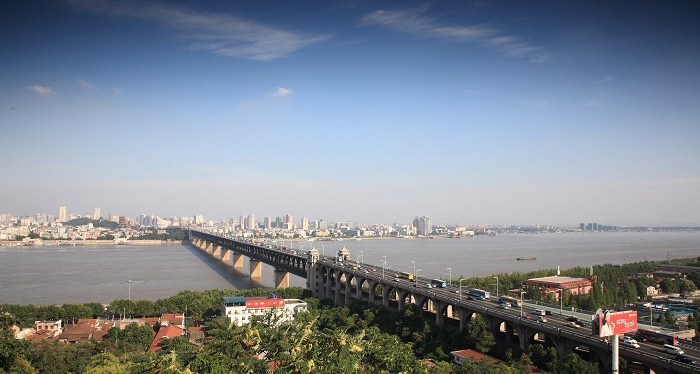Forum explores development of mid-Yangtze city clusters

The Wuhan Yangtze River Bridge is a local landmark in Wuhan, Hubei Province. Urban clusters to be formed around the city aim to fuel economic growth and urban development.
Sponsored by the Chinese Academy of Social Sciences (CASS) and the People’s Government of Hubei Province, and organized by China Society of Urban Economy, the Institute for Urban and Environmental Studies at CASS and Hubei Academy of Social Sciences, “Yangtze Forum” was held in Hubei Province on April 8. Experts and scholars attending the forum discussed the new concept, mode, mechanism, path and direction for the collaborative development of city clusters along the middle reaches of the Yangtze River.
The clusters will mainly be around Wuhan, Hubei Province; Changsha-Zhuzhou-Xiangtan, Hunan Province; and Poyang Lake, Jiangxi Province. They will cover a total area of 317,000 square kilometers, according to the State Council.
New economic growth engine
Speaking at the forum’s opening ceremony, Li Peilin, vice president of CASS, noted that China’s economic landscape has undergone radical adjustment since reform and opening-up, with the impact on Central China development particularly prominent. To further carry forward this trend and implement the “Rise of Central China” strategy proposed in 2004, it is necessary to create a new economic growth engine through collaborative development of the Central China plate and the middle reaches of the Yangtze River.
Developing city clusters along the middle reaches of the Yangtze River provides a platform for enhancing cooperation between regions in Central China, especially between Hunan, Hubei and Jiangxi provinces, and promotes industrialization, urbanization and agricultural modernization, said Li.
“If the Yangtze Economic Belt is the ‘scales,’ then its middle reaches is the ‘fulcrum,’” said Xu Kuangdi, an academician with the Chinese Academy of Engineering, in his speech at the forum. China last year began creating an economic belt along the Yangtze to promote better coordination in industrial development and more efficient allocation of resources among provincial regions traversed by the river.
Top-level design
To develop city clusters along the middle reaches of the Yangtze River is a systematic project. A good top-level design and institutional arrangement is essential for drawing a blueprint for the project and exploiting advantages of the clusters.
Li proposed four areas for breakthroughs. First, to enhance the collaborative development of the clusters to give full play to their respective advantages in capital, technology and human resources.
Second, to pay close attention to the development mode; urbanization of the clusters can be different from coastal city clusters, as rural residents in city clusters along the middle reaches of the Yangtze River can be guided to realize urbanization in nearby townships and small cities rather than by going to big cities.
Third, to choose the right development path; food safety is a prerequisite for urbanization, and a development path should be explored that protects agriculture and farmlands while carrying out urbanization.
Fourth, to focus on the new-type opening-up in the clusters, which represents an innovated “inland opening-up” pattern. The key to this pattern is the collaborative development within the clusters by efficient allocation of resources among these regions.
Besides serving as the new economic growth engine, city clusters along the middle reaches of the Yangtze River are also leading in the construction of a “resource-conserving society” and “environment-friendly society.”
In terms of the low-carbon development of city clusters along middle reaches of the Yangtze River, Wan Bentai, chief engineer of the Ministry of Environmental Protection, shed light on the cross-region ecological improvement. He called for deeper and more extensive cooperation in environmental protection between governments.
Wan said that these efforts would set examples not only for cross-region environmental cooperation nationwide, but also for overall development of the river basin and comprehensive improvement of water environment in China.
Ma Xianzhong, Hao Rihong are reporters at the Chinese Social Sciences Today.
